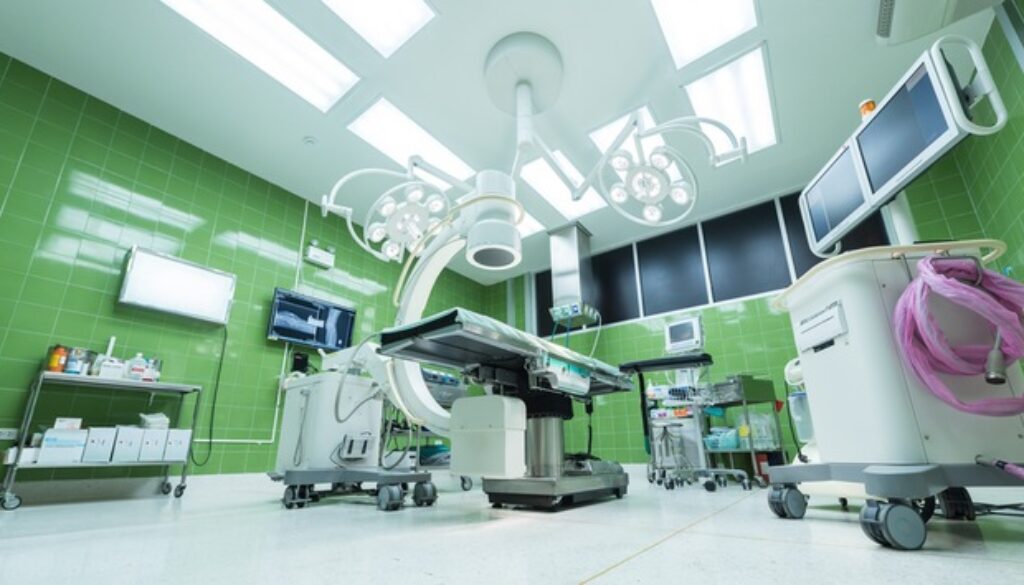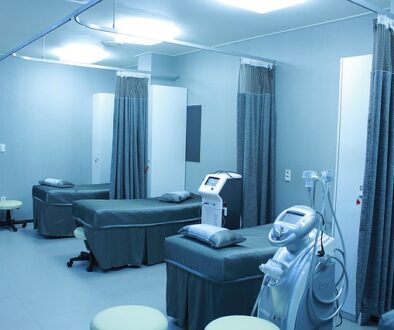Guide to LED Lighting for Healthcare
An LED, or Light-Emitting Diode, works by electroluminescence – its material emits light in response to an electric current or field. By contrast, incandescence works by visible light being emitted as a result of the high temperature of its material, while fluorescence is the emission of light by a substance (phosphorus in fluorescent bulbs) that has absorbed light. Incandescent bulbs were developed as far back as the late 1800s. Fluorescents took off in the 1930s, and LEDs had their start in the 1960s. As the technology continues to develop, LEDs have recently become more affordable and have been found in a wider variety of applications. For healthcare, this allows for more durable, efficient, and environmentally sound lighting for exams and surgeries.
The benefits of LED lights are many. There is no warm-up time as with incandescent bulbs, so an LED will reach full brightness much quicker. Because LEDs do not rely on high temperatures to produce light, they generate much less heat than incandescent lights, which results in a more comfortable working environment. Although they are smaller, LEDs consume less energy than halogen bulbs at the same intensity of light; in fact, LEDs produce more lumens per watt than incandescent bulbs. LED light can be dimmed and focused, and color can be achieved without using filters.
Another benefit of LED lights is their durability. LEDs are shock-resistant, unlike fragile incandescent and fluorescent bulbs. Fewer LED bulbs will be needed than other types of bulbs over the same period of time. Incandescent bulbs have an estimated life of 1,000 to 2,000 hours, and halogens have a lifespan of 2,000 to 3,500 hours. Fluorescent lights have much a longer expectancy of 10,000 to 15,000 hours, and LED lights more than double that range. Unlike these other types of bulbs which go out suddenly at the end of their use, LEDs gradually dim. An LED light can last up to 30,000 hours before significant dimming is observed, with an overall estimated useful life between 35,000 to 50,000 hours.
So how do you compare different models of LED lights to find the best value for your exam or operating room? There are few different measures of quality you’ll want to review.
First, there is light intensity, which is measured in lux. One lux is equal to one lumen over one square meter, or for reference, know that: a) direct overhead sunlight is approximately 130,000 lux, and b) the higher the lux number, the brighter the light. Intensity is determined by the strength and arrangement of bulbs, so even a product with fewer LEDs than its competitor could be brighter due to the strength and placement of its bulbs.
Next, Correlated Color Temperature (CCT) is measured in degrees Kelvin and indicates the color of light produced by the bulb. The higher the number, the whiter the light produced, and the more accurately the objects under the light will be perceived. Natural daylight is in the 4,000 to 6,000 range, which is also standard for most LEDs. Color temperatures above this range are cooler and slightly bluer, and those below it are warmer and a little more yellow or orange. Depending on what needs to be observed under the light, different temperatures may be ideal – or physicians may prefer different temperatures than each other for the same procedures. For this reason, you will find that most exam lights are standardized within the range of natural daylight, while many surgical lights have adjustable temperatures so that the best temperature can be selected for each procedure as needed.
Another measure of how closely a light reveals the color of an object as compared with how that object looks under natural light is the Color Rendering Index (CRI). The highest possible value is 100, identical to daylight; LEDs will have CRIs of 80 or more.
Other considerations when reviewing your LED light options are maneuverability of the light head, the size of the area of light produced, and shadow control. Shadow control is possible with LED lights because manufacturers are able to design the lights so that some of the tiny bulbs will shut off or dim in the presence of something obstructing the path of its light so that no shadows are produced and instead light is directed where it is needed for the procedure.
Before deciding, see the light in person. Ask vendors if they can bring in a light on rolling stand so that you can try it out inside your operating or exam room, or ask nearby facilities of similar size if you can observe their light in action. If you are able to discuss a particular LED light with a facility that has been using that model for a while, request their opinions on maneuverability, stability, focus, and shadow control based on their experience using the light for their procedures and exams. An important part of the planning process if you have an integrated OR and decide on an LED light from a different vendor is to confirm with each vendor that this will be compatible and to request room plans to avoid issues with lights or booms bumping into each other or your staff.
Many medical equipment manufacturers offer quality LED lights for the healthcare industry; here are examples of both exam and surgical LED lights available from just a few manufacturers, STERIS, Skytron, and Trumpf Medical:
EXAMPLES OF LED EXAM LIGHTS
| Manufacturer | Model | Intensity | CCT | CRI | Average Life |
| STERIS | Harmony LED385 | 50,000 lux | 5000 K | 90 | 30,000 hours |
| Skytron | Triango | 55,000 lux | 4500 K | 95 | 30,000 hours |
| Trumpf Medical | TruLight 1000 | 80,000 lux | 4500 K | 95 | 50,000 hours |
EXAMPLES OF LED SURGICAL LIGHTS
| Manufacturer | Model | Intensity | CCT | CRI | Average Life |
| STERIS | Harmony LED | 160,000 lux | 4400 K | 97 | 30,000 hours |
| Skytron | Aurora Four AUA5 | 160,000 lux | Adjustable: 4100 K or 4500 K | 96 | 40,0000 hours |
| Trumpf Medical | iLED 3 | 160,000 lux | Adjustable: 3500 K, 4000 K, 4500 K, or 5000 K | 98 | 40,000 hours |
Come Get To Know Us!
To learn more about Partners healthcare Group and the many services we offer, please visit us online at www.PHGWorks.com, call us at (615) 370-5014, or toll-free at 1-800-270-7582 . You can also visit us on Facebook, Twitter, Google or LinkedIn! We look forward to working with you in the future!



